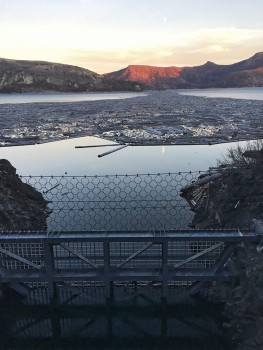Spirit Lake Intake Gate Replacement and Geotechnical Drilling
After 40 years, continued improvements are needed to support operations and maintenance of the Spirit Lake infrastructure that controls water levels in Spirit Lake.
Work on the multi-year intake gate replacement project and geotechnical drilling project is underway. Weekday recreation trail closures within the Mount St. Helens National Volcanic Monument will be ongoing during the multi-year construction effort. Visit the Gifford Pinchot National Forest website for updates: www.fs.usda.gov/giffordpinchot
Temporary closures are needed to mobilize appropriate equipment, materials and supplies, implement project work, and ensure a safe work environment. Visitors can expect to see large construction equipment and materials. Dust may be seen from various locations on the Monument. Visitors will encounter large vehicles on Forest Road 99 and are advised to use caution when traveling to the area.
Background: When Mount St. Helens erupted in 1980, a debris avalanche carrying 3 billion cubic yards of sediment formed a natural dam that blocked the outlet of Spirit Lake, where it had previously flowed into the North Fork of the Toutle River. If this debris blockage were dislodged by high lake levels in Spirit Lake, an estimated 2.6 billion cubic yards of sediment would flow into the Toutle, Cowlitz and Columbia Rivers, causing loss of life and significant damage.
In 1985, emergency construction was completed on a 1.6 mile long, 11-foot diameter tunnel and associated intake gate structure to regulate water levels in Spirit Lake. Limited geotechnical information for the debris blockage was obtained at this time due to the emergency nature of the work.
The Forest Service operates and maintains this aging tunnel system. Despite the overall success of the existing tunnel, major repairs in 1995, 1996, and 2016 required extended closures of the tunnel gate and outlet flow, which allowed the lake to rise to the maximum safe operating level. Aging infrastructure and the absence of redundant safety measures for the intake gate itself necessitate the need to replace the existing gate to support safe operations and maintenance of the Spirit Lake infrastructure, downstream communities, and users accessing the area during construction.
Current Work: The goal of the current intake gate replacement project is to improve lake level management, safety, monitoring, and inspection of the tunnel infrastructure. This work is being accomplished by replacing the current single fracture-critical steel gate with a double redundant gate system with two flow paths, each through two separate gates. Replacement of the gate requires reconstruction of a temporary access road to the lake surface. This temporary access road follows the Truman Trail, the route used in 1985 to construct the existing tunnel. A barge loading facility will be constructed to mobilize equipment over the lake to the existing tunnel inlet, and a coffer dam will be constructed to dewater the existing intake gate structure during construction of the new gate.
Future Work: Geotechnical subsurface drilling is scheduled to begin in 2025. This data will help the Forest Service more fully understand the existing conditions of the debris blockage and predict safe operating conditions for the existing infrastructure. Information obtained from the drilling will also help inform potential alternate systems for managing Spirit Lake water levels.



